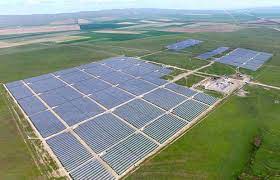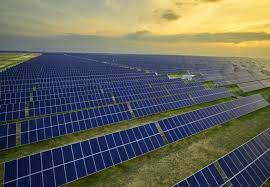Courtesy : scroll.in
Solar park
While the sun shines, over half of Delhi’s metro trains run on power generated 800 km away in a solar park in Rewa, Madhya Pradesh.
At the solar park, spread over 4,000-acre, roughly the size of 3,000 football fields, a sea of panels touched the horizon in every direction in December. In the quiet breeze, I found it nearly impossible to spot a single soul against the mirage effect. Cows, foxes, and snakes seemed to outnumber the human
Only when the sun set and the power generation dimmed, a few scattered construction helmets poked out from the sea, hovering alongside a gush of water meant to remove the dust on the panels to increase their power efficiency.
One of the workers, Durvesh Kumar Sharma, said he was paid Rs 30 to hose down one panel. For the roughly 20 panels that he washed every day, he earned about Rs 6,000 to Rs 9,000 per month.
“It’s going well here,” he said. “We can feed our stomachs and the work is good.”
Sharma used to work at a Bangalore cloth factory before moving back to his home village four years ago to help construct the plant. “At least our work is now near our home and we can live with our family,” he said.
But not many share the good fortune.
The sprawling unit, one of the three in the park, employs just 60 workers, including Sharma, to hose down the modules every day. The other two units employ even fewer cleaners at 40 each.
During the monsoon, even these labourers’ contracts are not renewed. “In the rains, my labour count goes to zero,” said Sachin Gupta, a cluster manager with Mahindra Teqo, the company that manages operations in all three units which are owned by different companies.
The park was set up by Rewa Ultra Mega Solar Limited, a joint venture between Madhya Pradesh Urja Vikas Nigam Limited and the Central government’s Solar Energy Corporation of India.
A Madhya Pradesh Renewable Energy Department presentation made in 2019 states that the Rewa project was expected to create 2,250 skilled and 7,500 unskilled “man-days” during construction and 522 skilled “man-days” during operations every year for the next 25 years. Man-days refers to the number of days worked.
A presentation prepared by the Urja Vikas Nigam Limited states that the project provides employment to roughly 3,000 direct workers and 2,000 indirect ones every day.
But a visit to the solar park in December and interviews with all three units’ officials revealed that only about 430 people were working at the park, including unskilled module cleaners and vegetation cutters as well as skilled technicians and managers. The vast majority of unskilled labourers were local, but over half of the 49 skilled technicians were not. Only one site manager, out of all seven, was from
In a series of ground reports, Scroll.in is examining the changing labour patterns of two major energy sources, coal and solar. With employment levels touching a new low in India, the country’s ability to chart a green future will be tested against the jobs challenge.
Rewa’s solar park was built at a cost of Rs 4,500 crore. At its bidding, in 2017, it was India’s cheapest energy provider, with a tariff of less than Rs 3 per unit – lower than the prevailing tariffs of Rs 4.5 from coal-fired thermal plants. Former chairperson of the Rewa Ultra Mega Solar Limited, Manu Srivastava, now Principal Secretary in the Madhya Pradesh government, attributed this mostly to a unique payment security mechanism, which decreased the developers’ risk.
While many solar park projects in the country have run into land acquisition challenges, the Rewa project was lucky in that 80% of the area earmarked for it was government land – an army firing range. The area surrounding the three main villages at the park was mostly rocky terrain used by pastoralists.
Billed as Asia’s largest single-site solar park and inaugurated by Prime Minister Narendra Modi in 2020, the greenfield park showcased the new economic viability of green power – it reportedly reduces India’s carbon emissions by 1.5 million tonnes annually. The project won a prestigious World Bank award in 2017 and is being studied at the Harvard Business school.
India’s renewable energy ministry and the World Bank have often argued that it should be taken as a blueprint for the country and the world.
District authorities take pride in the fact that Rewa’s name has become almost synonymous with the project. “My friends from outside hear Rewa and now think of only the plant,” said district collector Ilayaraja T. “It’s obviously become an identity for the district. Politicians proudly mention that Rewa gives electricity to Delhi Metro.”
But the collector is aware that the enthusiasm for the project among local residents has gradually dimmed. Initially, young people and farmers were excited to see that at least 1,500 people were employed during the construction phase. Once it was clear that those weren’t permanent features, the complaints slowly brewed. “Obviously people would’ve expected more jobs,” Ilayaraja said.
For many local residents, the point of comparison are the cement plants in the district, run by Jaypee and Ultratech. Each of the plants employ about 1,000 workers, said Ilayaraja. The other source of employment is the coal and thermal energy industry in Singrauli, one of India’s densest power generation clusters, about 150 km from Rewa.
“The mines there give a lot of employment. I’ve seen it,” said Shivraj Patel, who drives the 30 km back and forth between Rewa city and his village Badwar several times a week, shuffling Mahindra employees to the solar park that now sits on his village’s land. Patel’s family gave seven hectares of their land at Rs 12 lakh per hectare to the solar park. Many from his village, predominantly home to Adivasis and Other Backward Caste communities, are working in the plant, he said, but it is no match for Singrauli’s coal employment.
The numbers game
Last year, India’s capacity to generate electricity from solar energy grew at the fastest rate in the world, doubling its new installations as compared to the previous years. According to government numbers, solar power capacity has increased by more than 11 times in the last five years.
Despite the accelerated growth in renewables, coal remains the country’s main energy source. The environment minister has made clear that renewables would make for an additional input rather than a replacement.





